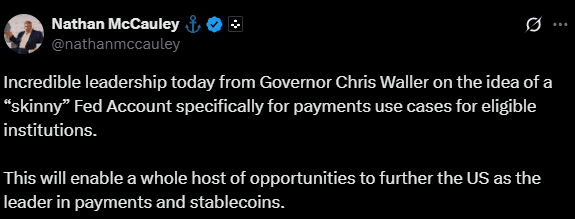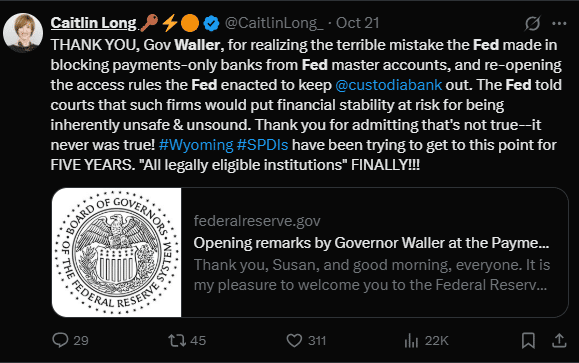The U.S. Federal Reserve is exploring limited access to its payment rails for stablecoin issuers, as announced by Governor Christopher Waller, to integrate crypto innovations like stablecoins into the mainstream financial system while minimizing risks and enhancing efficiency.
-
Fed Governor Waller proposes a ‘skinny master account’ for stablecoin firms to directly connect to payment systems without relying on intermediary banks.
-
This move acknowledges the mainstream adoption of distributed ledgers and crypto-assets in payments and finance.
-
Crypto industry leaders, including executives from Anchorage Digital and Visa, view it as a step toward greater legitimacy and U.S. leadership in stablecoins, potentially reducing costs by up to 30% for transactions.
Federal Reserve stablecoin integration: Explore how Gov. Waller’s proposal could revolutionize U.S. payments with direct access for crypto firms. Discover benefits for stablecoins and tokenized assets today.
What is the Federal Reserve’s Plan for Stablecoin Integration?
Federal Reserve stablecoin integration involves granting select innovative firms, particularly stablecoin issuers, limited access to the central bank’s payment infrastructure through a streamlined “master account.” This initiative, highlighted by Governor Christopher Waller at a recent payment innovation conference, aims to embed crypto technologies like stablecoins into the U.S. financial fabric without compromising system stability. By doing so, it reduces dependency on traditional banking intermediaries, potentially speeding up settlements and lowering operational costs for participants.
How Will This Access Benefit Crypto Firms and the Broader Economy?
The proposed “skinny master account” would enable stablecoin issuers and fintech entities to hold reserves directly with the Federal Reserve, allowing instant transaction settlements. This structure mitigates risks associated with third-party banks, which have historically imposed higher fees and delays—sometimes adding 20-25% to processing costs, according to industry analyses from sources like the Bank for International Settlements. Waller emphasized that stablecoins, now representing over $150 billion in market capitalization as of 2025, have evolved from niche experiments to essential tools for cross-border payments and remittances.
Supporting this shift, Waller’s remarks underscored the transformation in the sector: “This is an acknowledgement that distributed ledgers and crypto-assets are no longer on the fringes but increasingly are woven into the fabric of the payment and financial systems.” Experts from the Federal Reserve’s own research papers, including those on digital currencies, highlight how such integration could enhance the U.S. dollar’s global dominance by modernizing payment rails to compete with faster international systems like Europe’s TARGET2-Securities.
In practical terms, this access would streamline operations for entities handling tokenized assets. For instance, stablecoin transactions, which processed $10 trillion in volume last year per Chainalysis reports, could see improved liquidity and reduced counterparty risks. The initiative also aligns with broader regulatory pivots under the current administration, rolling back previous restrictions that limited banks’ involvement with digital assets. This cautious yet forward-thinking approach demonstrates the Fed’s growing expertise in balancing innovation with financial safeguards, drawing on consultations with economists and technologists within its own advisory councils.
Frequently Asked Questions
What Changes Has the Federal Reserve Made Regarding Crypto Access in 2025?
In 2025, the Federal Reserve has shifted toward embracing stablecoin integration by proposing limited master accounts for qualified crypto firms, as outlined by Governor Waller. This reverses earlier denials, such as those for Custodia Bank, citing reduced risks from matured sector oversight and clear guidelines from the Office of the Comptroller of the Currency, fostering safer innovation without speculation.
Why Do Stablecoin Issuers Need Direct Fed Access for Payments?
Stablecoin issuers gain from direct Federal Reserve access because it allows holding reserves centrally and settling payments instantly, bypassing costly intermediaries. This setup, ideal for high-volume transfers, enhances reliability and cuts fees, making U.S. stablecoins more competitive globally, as noted in Wall Street Journal coverage of payment system efficiencies.
Key Takeaways
- Fed’s Embrace of Stablecoins: Governor Waller’s proposal for limited master accounts signals official recognition of crypto’s role in payments, integrating stablecoins to boost efficiency.
- Industry-Wide Benefits: Firms like Ripple and Anchorage Digital stand to gain reduced costs and faster settlements, with experts predicting a surge in tokenized asset adoption.
- Regulatory Evolution: This move under the pro-crypto administration paves the way for Wall Street’s blockchain entry, urging stakeholders to prepare for compliant innovation.
Crypto Leaders Welcome the Move
Industry stakeholders have responded positively to the Federal Reserve’s openness toward stablecoin integration. Master accounts function as direct reserve-holding privileges with the central bank, empowering fintech and crypto entities to execute real-time settlements independently. This eliminates intermediaries, which often inflate expenses—data from the Federal Reserve Bank of New York’s own studies indicate potential savings of 15-30% in transaction fees for large-scale operations.
Companies such as Ripple, which sought a master account and banking charter earlier this year, could see significant operational advantages. The payment innovation conference drew influential figures from tech and finance, who described the development as transformative. Nathan McCauley, CEO and Co-Founder of Anchorage Digital, stated, “This will enable a whole host of opportunities to further the US as the leader in payments and stablecoins.”

Source: X
Rob Hadick, General Partner at Dragonfly, a prominent venture capital firm, noted that this policy adjustment would accelerate the inevitable uptake of tokenized assets and stablecoins across global markets. Cuy Sheffield, Head of Crypto at Visa, labeled the initiative “powerful” for its potential to unify traditional and digital finance. Similarly, Tom Lee, CIO at Fundstrat, interpreted it as groundwork for broader institutional involvement, saying, “This is a step towards facilitating moving Wall Street onto the blockchain.”
Historically, the Federal Reserve maintained a conservative stance during the prior administration, viewing crypto activities as potentially destabilizing. Institutions like Custodia Bank faced repeated denials for master account access, with regulators citing concerns over safety and systemic risks. Caitlin Long, founder of Custodia Bank, welcomed Waller’s comments, reflecting on their five-year pursuit: she highlighted how persistent advocacy has contributed to this regulatory thaw.

Source: X
By April 2025, many anti-crypto measures were rescinded, including prohibitions on banks servicing digital assets. This evolution reflects a maturing regulatory landscape, informed by input from bodies like the Financial Stability Board and internal Fed analyses, which now emphasize stablecoins’ stabilizing potential in volatile markets. The proposal underscores a commitment to innovation, positioning the U.S. as a frontrunner in digital payments amid competition from jurisdictions like Singapore and the UAE.
Furthermore, this integration could amplify stablecoins’ utility in everyday finance. With daily transaction volumes exceeding $100 billion, as tracked by metrics from Dune Analytics, direct Fed access would ensure parity with conventional systems. Economists at the IMF have echoed these sentiments in recent reports, advocating for central bank involvement to harness blockchain’s speed and transparency while applying robust risk controls.
The broader implications extend to tokenized securities and real-world assets, where stablecoins serve as the foundational layer. By facilitating seamless interoperability, the Fed’s strategy could unlock trillions in value, according to projections from Boston Consulting Group. This measured approach—balancing access with safeguards like capital requirements and audit mandates—exemplifies professional oversight in a rapidly digitizing economy.
Conclusion
The Federal Reserve’s push for stablecoin integration marks a pivotal moment in U.S. financial evolution, with Governor Waller’s “skinny master account” proposal offering crypto firms direct pathways to payment rails. This development, welcomed by leaders from Anchorage Digital to Visa, promises enhanced efficiency, cost reductions, and legitimacy for tokenized markets. As regulations continue to adapt, stakeholders should monitor upcoming policy refinements to capitalize on these opportunities in the thriving digital asset landscape.
